Thirty days in Thailand and I’ve yet to see the inside of a hospital.
Anyone who hasn’t read the hashtags on my Instagram pictures carefully or – more likely – shared a meal with me may very well be rolling their eyes. Oh the big, scary world; did you really *think* you’d end up in the hospital? I can hear you saying now.
Well, the truth is, yes. I did.
I’ve lived 30 days in Thailand with a very severe peanut allergy – and I’ve yet to see the inside of a hospital.
Disclaimer #1: This post is in no way the definitive truth on Thai food, peanut allergies, Thai people or Thailand in general – it is simply about my experience living on a Thai island for 30 days with a very severe peanut allergy.
Disclaimer #2: In many discussions with friends, I always make it clear – my allergy is in no way a barrier. It is not a disability I’ve had to overcome nor something that is out of my control to handle – and I am in no way trying to insinuate that it causes an accessibility obstacle to travel.
You may say I was paranoid, or overdramatic, or overreacting as I boarded my flight complete with five epi-pens and 20 granola bars, searching the airport shops for cloth masks (spoiler alert: I found them in the Tokyo-Narita airport). But the truth is, I honestly believed I was heading for inevitable trouble.
30 days later, and I’m here to tell all peanut allergy sufferers: not only is travel in Thailand possible with a peanut allergy, but it is also a lot easier than I expected – if you’re careful.
So, why was I so nervous in the first place?
I always make a joke to people that of COURSE the two times I’ve been hospitalized for an allergic reaction were because of cake and ice cream – never, you know, a salad. (Hey, it’s really weird to put peanut butter ganache icing on a chocolate fudge cake. But I digress.) The thing is, it would be dessert, as most main course dishes that contain peanuts are Asian and my whole life, I have avoided much Asian food for this reason – particularly Thai food.
It hasn’t even been a fully intentional decision, either. As a teenager, before my allergy progressed further, I became ill from peanut oil at an Asian fusion restaurant; several times in my university days when I’d accompany groups of friends to Thai restaurants for dinner, I had to leave because the peanut smell made me overcome with nausea (cue sad, solo Pita Pit run).
Yes, I’ve always avoided Thai food. Then, when I began to do freelance travel writing for a Thai-based communications agency a couple years ago, I started my research on travelling to Thailand with a peanut allergy. The results? Downright disturbing.
I need to sidebar for a second here, because part of the reason I’m trying to document my experience so thoroughly is because most of the information out there on the interwebs about this topic is dated and just generally unhelpful (most – not all). And I would know; I’m pretty sure I’ve read every single individual web page on this topic thrice over throughout the last couple of years.
So – to all those people who I know mean so well but said some sort of variation of, “You’re going to Thailand, and you have a peanut allergy? You better be careful, you know.”
Yes. Yes, I do know. Thanks.
So what kind of stuff did I find on the web? Of course, the alarmists: forums where people downright said not to go to Thailand, that you’d have to eat food in very fancy hotels, that you wouldn’t be able to find anything to eat ever. That kind of stuff. I tried to brush it off…. but then I read and heard some very legitimate advice that made me think twice.
First, a sales associate for a very reputable group travel company flat out told me he would not feel comfortable selling a tour to me.
Second, this CNN article, which states: Meals in Thailand, where crushed peanuts sneak their way into everything from pad Thai to soup garnish, are like a nerve-racking game of edible Russian roulette.
(A game of edible Russian roulette. That phrase has seriously given me nightmares.)
And, of course, in the more credible travel forums, the real advice: that many Thai people may not understand what I’m saying, because of the language barrier and also the fact that allergies in general are just not common here; that cross-contamination, particularly at food stalls, will be an issue; that people will say they understand even when they don’t.
So, yeah, I was terrified. And I’m glad I was.
The truth about travelling Thailand with a peanut allergy? It’s just not that bad. That is, if you’re vigilant.
Being as nervous as I was forced me to be extra cautious and extra vocal to everyone around me until I had time to absorb my surroundings, talk to people, and take steps to feel more comfortable.
In that time, here are five truths I’ve come to realize:
1. Peanut oil isn’t used
Okay, maybe I should say “isn’t used much” or “rarely used” to avoid some sweeping cultural statement. But, it really isn’t.
Back home, peanut oil (the mere smell of it) is what has driven me out of every Thai restaurant; it is also my biggest cause for concern in restaurants, because it tends to sneak in unnoticed.
But here? I have only seen peanut oil once. Listed on an ingredient list. On a mayonnaise container. Of a western brand.
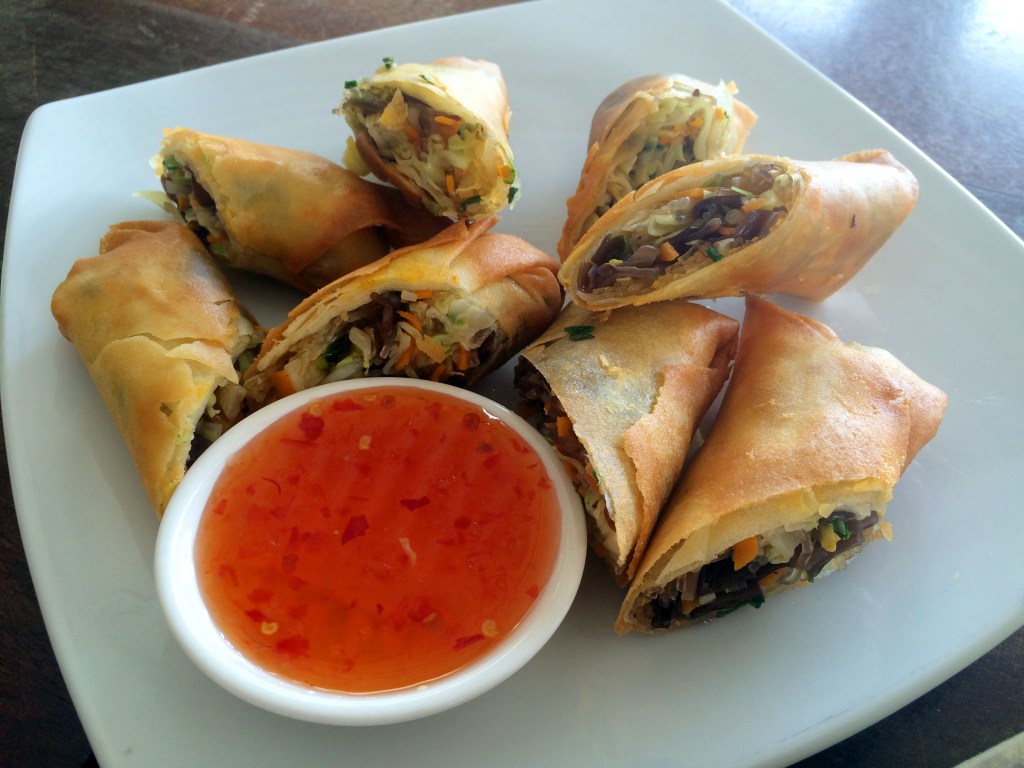 No peanut oil here – just all sorts of yummy deep-fried soybean oil goodness!
No peanut oil here – just all sorts of yummy deep-fried soybean oil goodness!
Every restaurant, ever food cart, ever Thai person I’ve spoken to cooks with palm oil, soybean oil, or maybe sunflower oil – never peanut oil. In fact, everyone seems to think I’m a little kooky for asking that (I’m okay with that – still going to ask – as it gives me a reassurance).
2. You will find food you can eat
If you’re like me and you’re wary of Thai food – at least at the start of your trip – you’ll still find food you can eat – and it won’t just be at large western chain hotels.
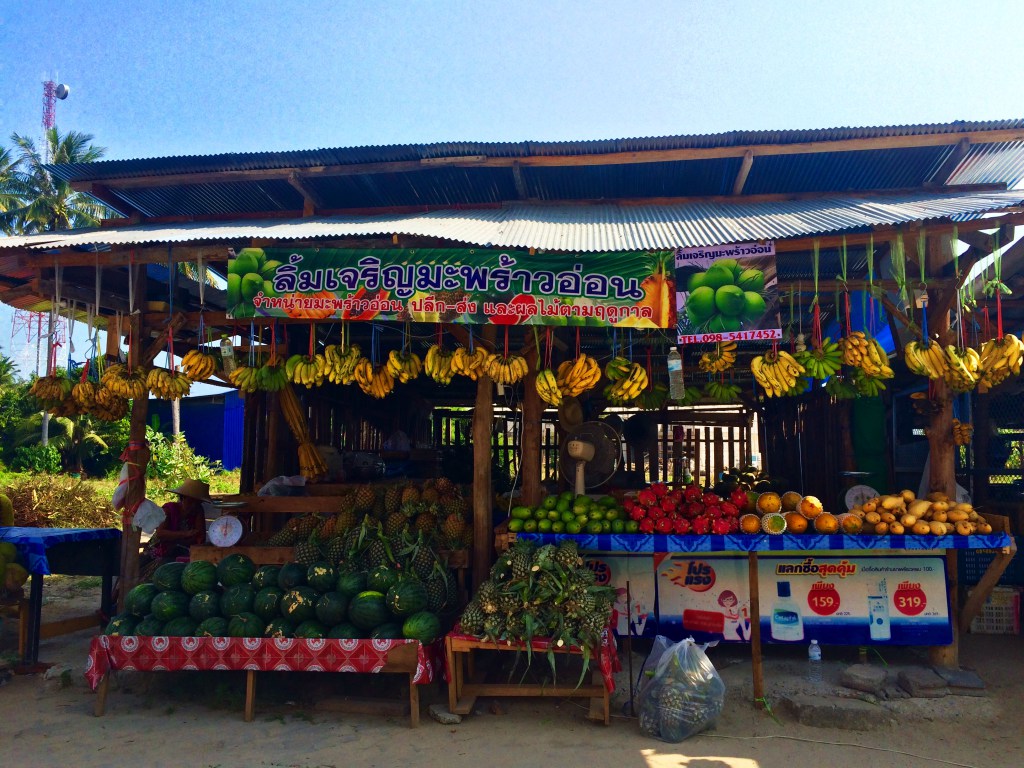
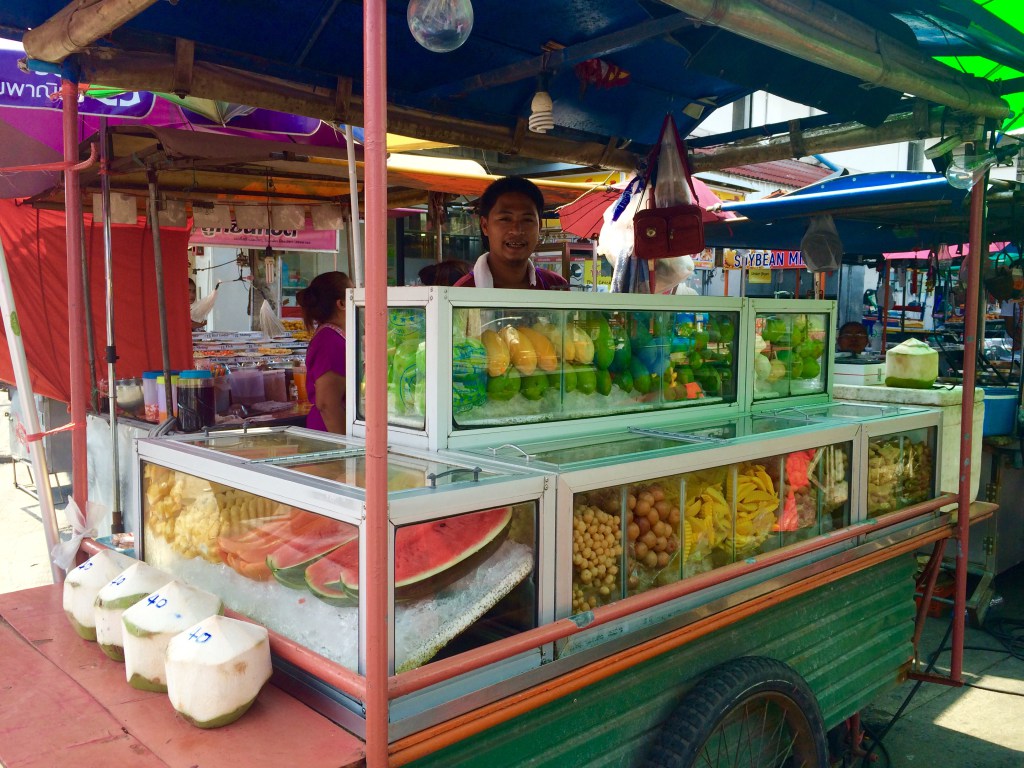
The first thing I fell in love with in Thailand? Fresh fruit. Everywhere. Papaya, mango, banana, pineapple: it’s an incredible explosion of colours at every corner – and sometimes being driven down the street on a portable stall.
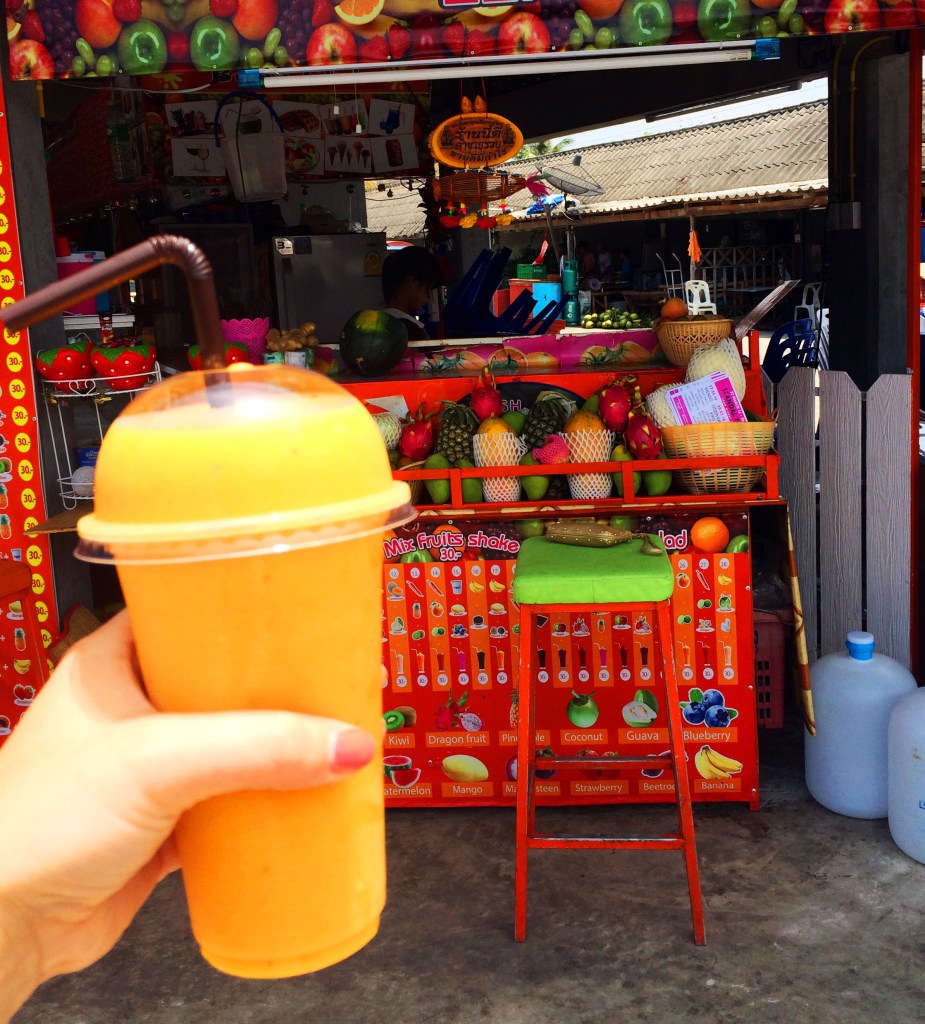
Then I became obsessed with the fruit shake. I have to admit, I’ve had one of these almost every day – and tried some pretty wonky combinations (avocado, coconut, and beetroot, anyone?). And I can’t even talk yet about my one true love, fresh coconuts: it’s too soon, I’m not even sure what to say.
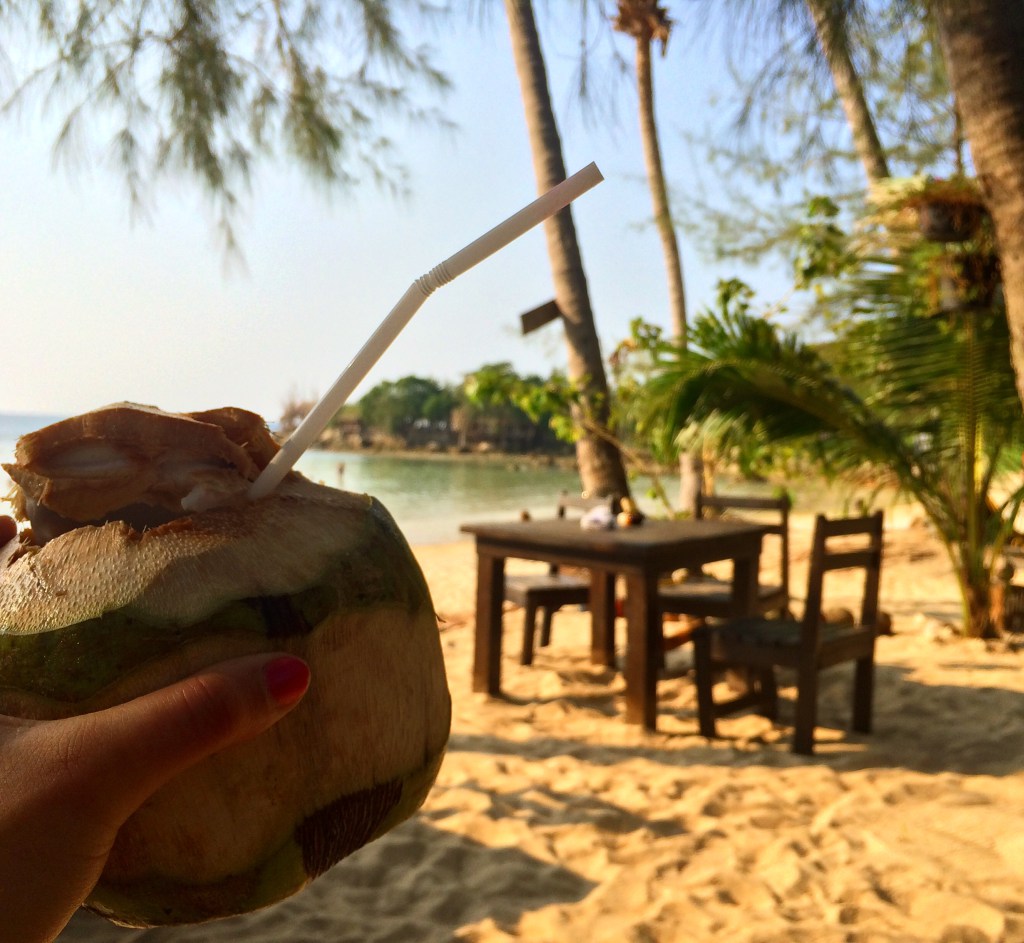
Next up, the seafood. OMG, the seafood when you live on an island is incredible. At the Panthip Night Market in Thong Sala I’ve enjoyed fresh grilled mackerel and squid like it’s no one’s business – and it’s pretty cool to see the squid boats out in the water every night, knowing exactly how fresh my next meal will be.
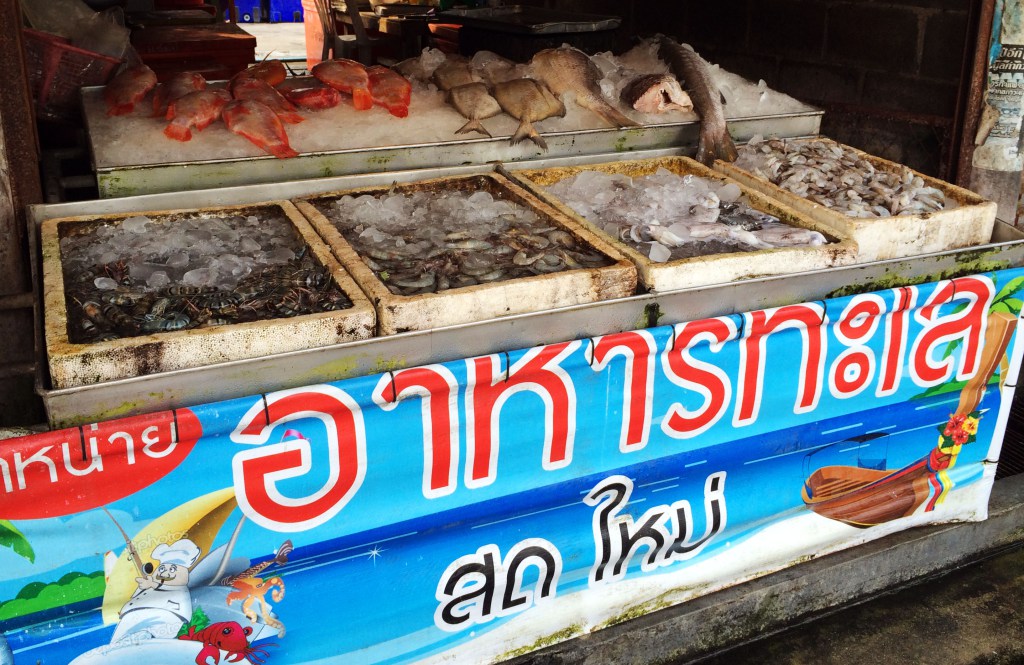
And finally, let’s talk about western food. First misnomer, that you can’t find it. Okay, okay – I have been living on an incredibly touristy island, but in my defence it is not an island with many chains (there are 7-11s everywhere, and a KFC inside a grocery store – and that’s about it). But at every coffee shop you can buy a croissant sandwich; around every corner is a restaurant selling burgers or pizza or pasta or sandwiches. The night market even sells sushi.
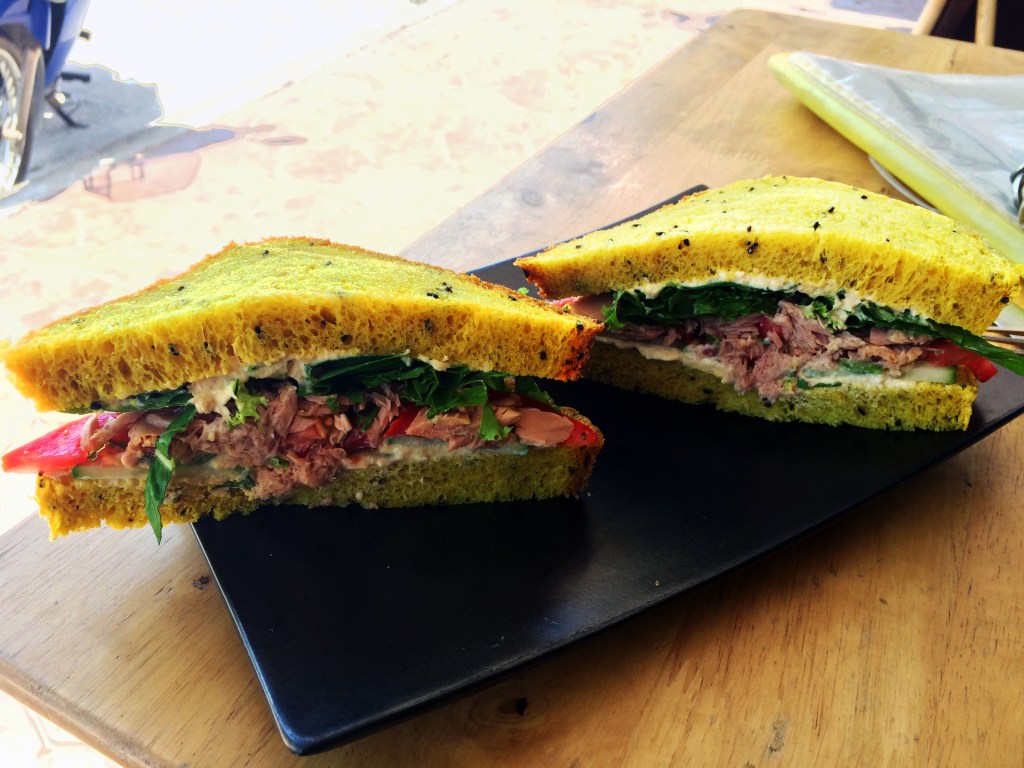
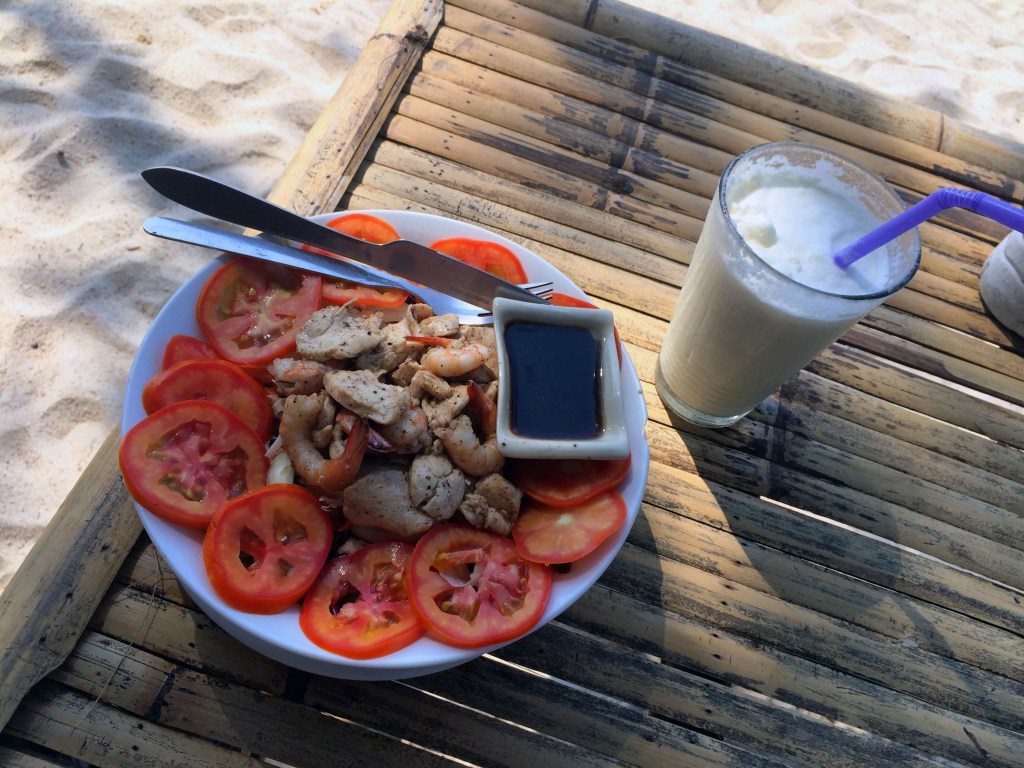
Is western food more expensive than Thai food? Yes, absolutely, but I’ve had some truly awesome western-style meals here.
3. People do get it, but you need to be clear
Another thing I read constantly before I travelled to Thailand was that Thai people would just not understand my allergy: not just because of the language barrier, but also because peanut allergies – and also, food allergies in general – are just not really a thing in Southeast Asia. Essentially, how do you stress the severity of an allergy that could kill you, when they’ve never heard of such a thing?
Perhaps this was how it was a certain number of years ago, before Thailand’s tourism boom, or maybe my experience is different because I live on a touristy island (stay tuned for an update when I head to northern Thailand in a couple weeks), but I have found this to be just plain wrong.
If you can get past the language barrier (translation cards by Select Wisely help immensely, as I’ve previously discussed), I’ve found most Thai people do understand my allergy – especially if I indicate my throat could close up in a little game of mini-charades.
That being said…. you do have to be very vocal about it.
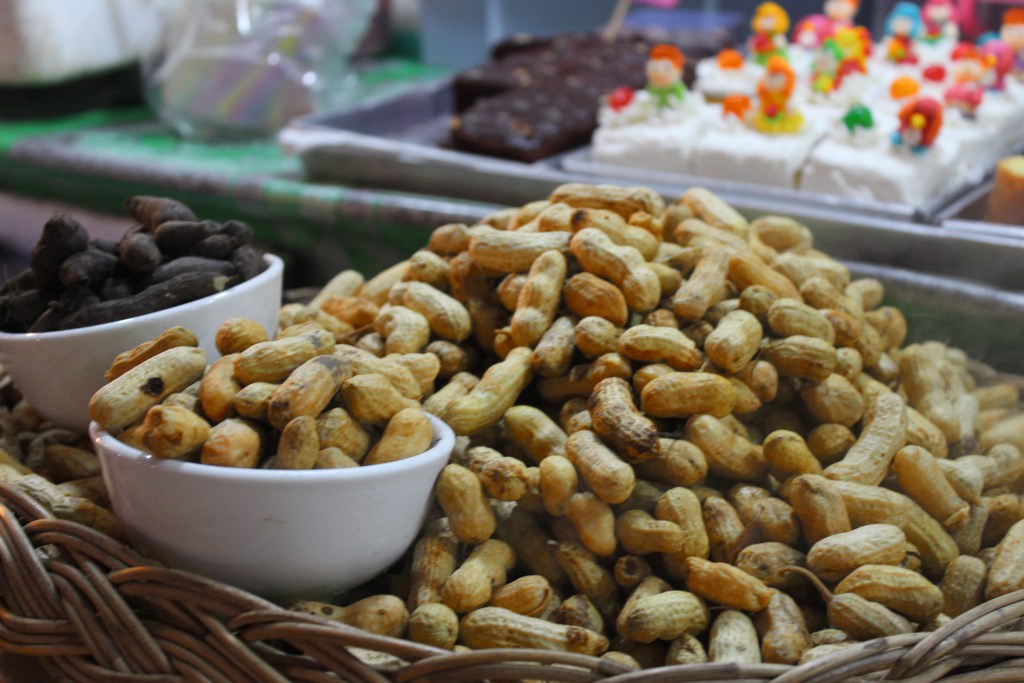
While peanut oil – my biggest fear – isn’t really prevalent here, peanuts are. In fact, they are everywhere – mostly in crushed form. I see little bowls of crushed peanuts on just about every food stall, accompanying most dishes, sprinkled on loads of food.
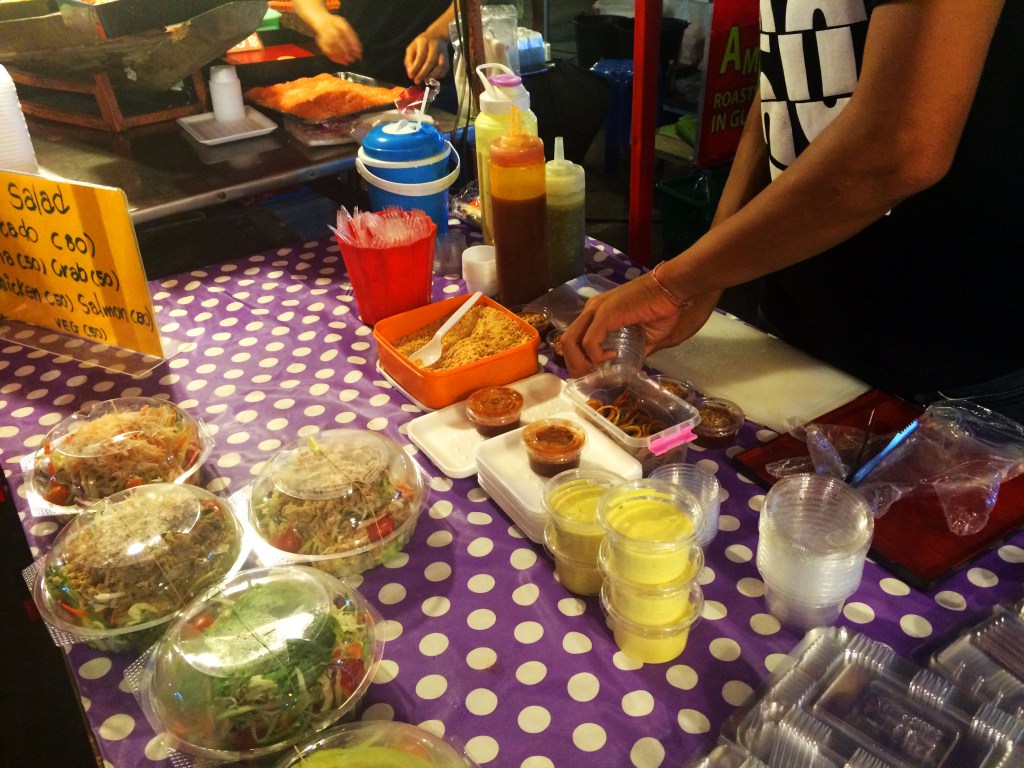 My favourite salad/fresh spring roll station in Panthip Night Market – but see that bowl of crushed peanuts?? There are also peanuts in each pre-packaged sauce container – I need to specifically ask them to pour me a new one.
My favourite salad/fresh spring roll station in Panthip Night Market – but see that bowl of crushed peanuts?? There are also peanuts in each pre-packaged sauce container – I need to specifically ask them to pour me a new one.
In some ways, this can make it easier – you can simply request that peanuts not be added to a sauce, a curry, a dish – but you need to speak up, loud and clear. And you know what helps with that? Going to food stalls.
4. You can eat at food stalls – in fact, you should!
I read many times over that because of my allergy, I should not eat at food stalls or trust street food. This is just wrong- and not because I’m about to speak passionately about how food at food stalls are delicious, cheap, and authentic (it is, but that’s not my point).
If you have a food allergy, you should absolutely eat at food stalls because you have direct contact with the chef, and a direct line of vision to how your food is prepared.
Regardless of what I’m getting – sushi, fresh spring rolls, fish, maybe even some Thai cuisine (see below) – I feel 100x safer ordering from a food vendor than I do a restaurant.
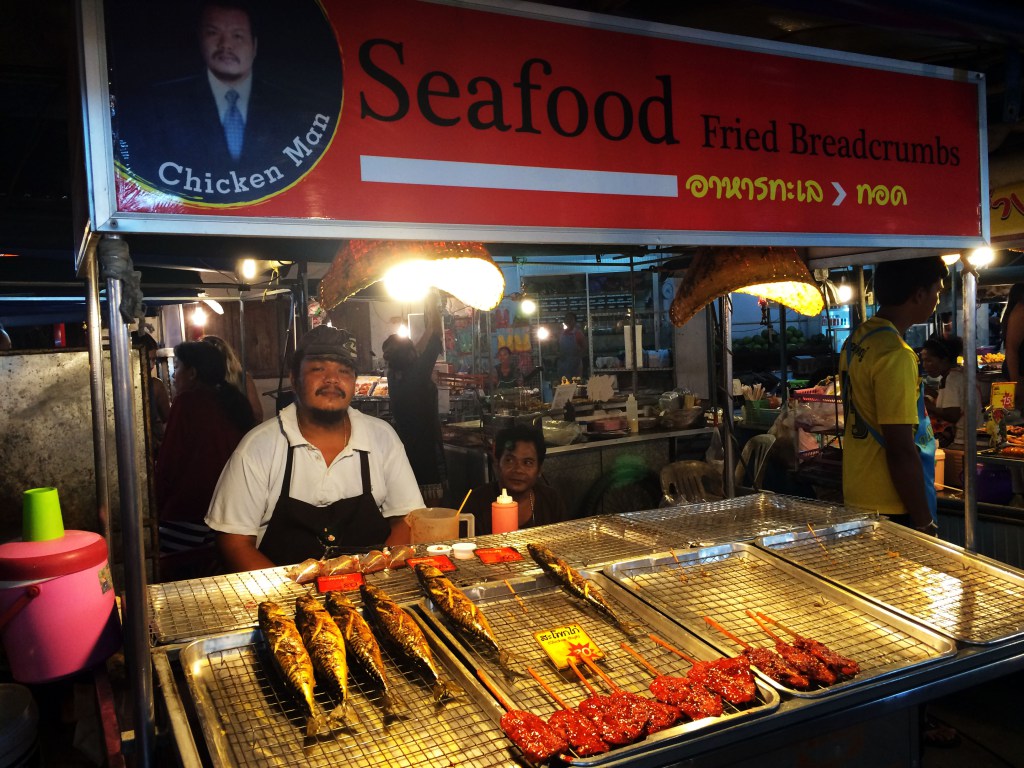
In a restaurant, you have to trust that the waiter both understands you and relays your message properly to the chef, who then also understands. You don’t see how your food is being prepared or (shudder) where those little bowls of crushed peanuts are.
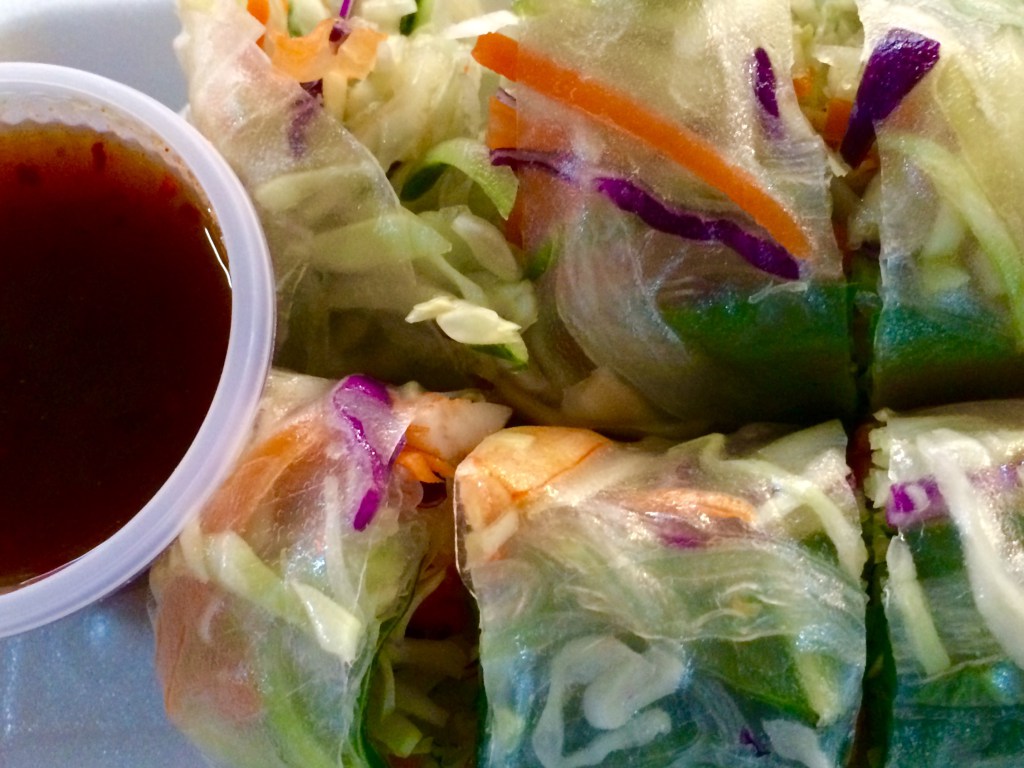 At my favourite fresh spring roll stall, none of the rolls have peanuts in them – but I always have to specify about the sauce.
At my favourite fresh spring roll stall, none of the rolls have peanuts in them – but I always have to specify about the sauce.
At a food stall, it’s all right there. You can talk to the vendor and see in their face whether they truly understand. You can watch them make or assemble your food. You can ensure the bowl of crushed peanuts stays far, far away.
You can feel safer eating your food – and that’s the whole goal, isn’t it?
5. You can eat Thai food
This truth – despite knowing that peanut oil isn’t around, despite feeling comfortable with street vendors – was the hardest one for me to accept.
A lot of the allergy game is a mind trick. If I can’t place the taste of certain spices, my mind immediately jumps to peanuts, and then all of a sudden my throat decides a fun game would be to pretend it’s actually having a reaction.
Does this sound familiar to anyone else?
This is a psychosomatic reaction, where (in truly scientific terms, I’m sure) your body mimics a certain physical reaction based on stress and anxiety.
(For anyone curious, how I deal with a psychosomatic reaction is by popping a Benadryl, trying to take long, deep breaths, and distracting myself by reading a book or watching something on TV. Normally after 20-30 minutes, since I’m clearly not having a reaction, my throat will decide the game is not fun anymore and go back to normal.)
For years, the words “Thai food” have immediately worried me; the thought of even going into a Thai restaurant has practically brought on a psychosomatic reaction. So you can understand my hesitation to testing out Thai food – even if there’s no peanuts in it, surely my body would start to think there was…
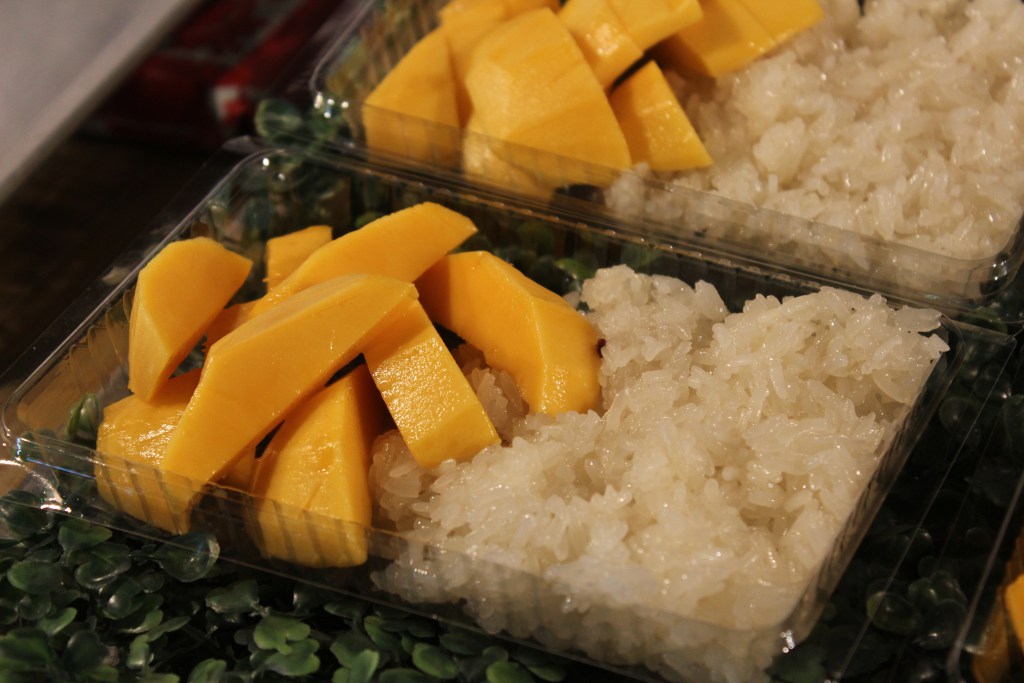 One glance of Mango Sticky Rice and I knew I needed to get over my Thai food anxiety.
One glance of Mango Sticky Rice and I knew I needed to get over my Thai food anxiety.
But then, I started to crave the idea of eating the cheap, delicious, local food. I am not a picky eater in the slightest, and I have always sought out the local cuisine while travelling; yet here I was, living in Thailand, eating fruit and fish and sushi and western food. (I mean, hey, not bad, but come on…)
I knew I had to get my mind over its issue with the idea of Thai food, so I did two things.
First, I enjoyed Thai food prepared by my dear friend and amazing cook, Chef Gam. I met Gam through mutual friends within my first few weeks on the island, and I jumped at the chance to go to her gorgeous villa for a girls’ night, especially when she said she was cooking – peanut free! She made a delicious red snapper fish with ginger, with a side of pad Thai.
Oh my god. Pad Thai. How have I been living my whole life without trying it??!
(Oh right. Americanized pad Thai is most often cooked with peanut oil. That.)
A few days later, she had the same group of girls back again, making pad Thai once again. This time, I brought dessert – mango sticky rice, which I watched the vendor prepare without sprinkling on those damn crushed peanuts.
I was sold.
I then did something I should have done on my first day in Thailand – I took a cooking class.
Chef May at My Wok and Me was one of the kindest, sweetest women I have ever met. Originally from Burma, May has been a cook on Koh Phangan for 16 years and now teaches two cooking classes a day; she told me she has had plenty of customers with peanut allergies, and it really is quite simply – don’t add the nuts.
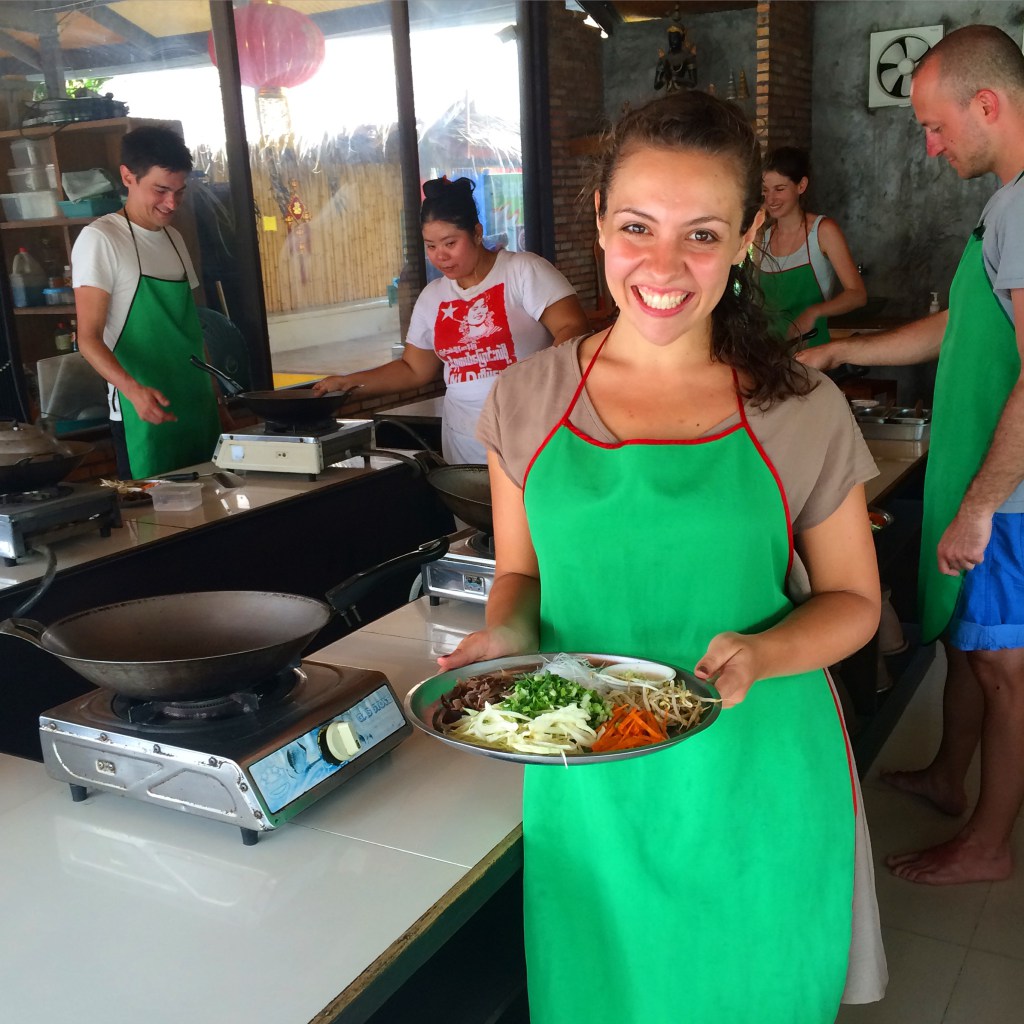
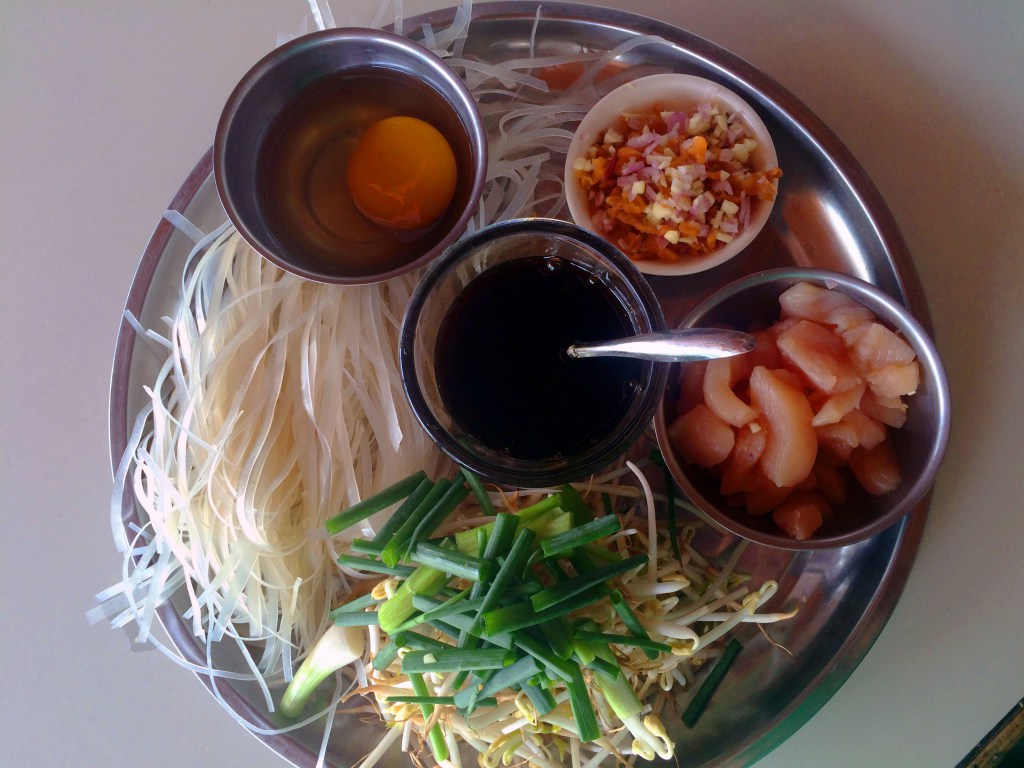
Together, the whole class made deep fried spring rolls, pad Thai, green curry, Massaman curry, and mango sticky rice. For me, I just did not include peanuts in the pad Thai or Massaman curry.
May also took time after the class to talk to me about a few other dishes – which ones are always fine, which ones I should ask about as they can vary, which ones to avoid, which ones I just need to watch how they prepare and make sure they use a new bowl. I left the class with reassurance, excitement to try a bunch of dishes, a recipe book and a TON of delicious (peanut-free) leftovers.
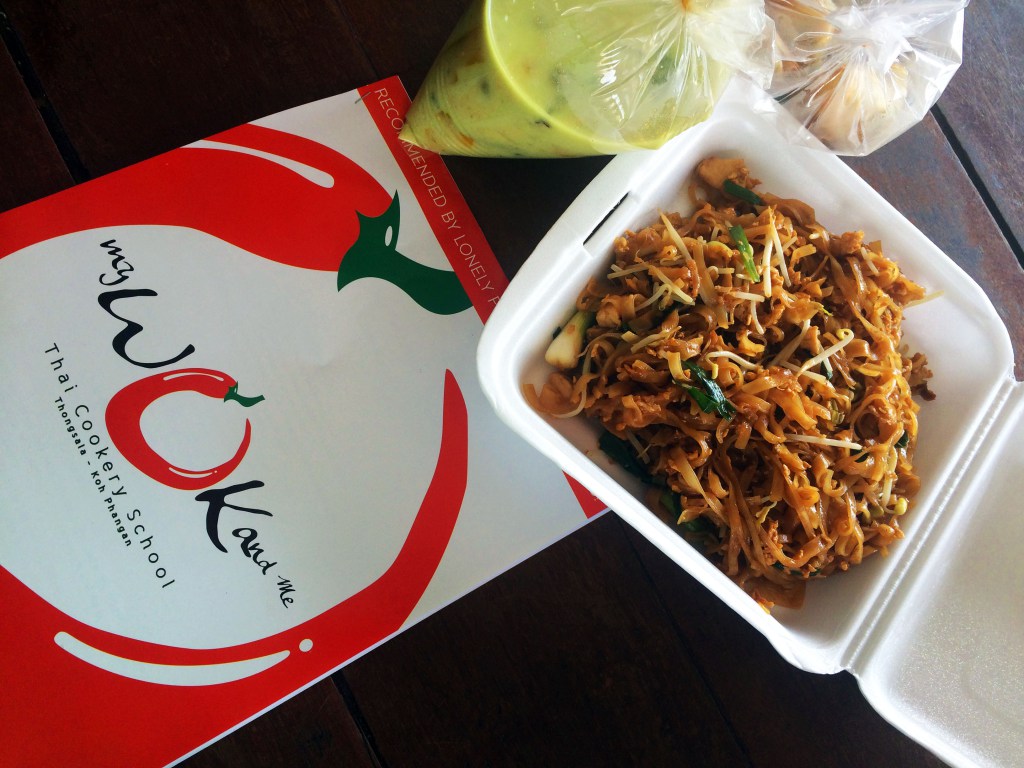
So – my major takeaways for anyone else with a peanut allergy (or another food allergy)?
When coming to Thailand, take a cooking class sooner as opposed to later. The sooner you can educate yourself on the dishes, the better. (It’s important to note that this should be done in Thailand and not in the western world, as cooking styles (namely the use of peanut oil) vary).
Still be cautious. Talk about your allergy with friends to make sure they know. Learn where all the hospitals are around you just in case. Bring your epi-Pen everywhere – even the beach.
If you can, stay somewhere for awhile to get comfortable with the language and the food. As I’ve been on Phangan a month, I know where to go for certain things, which food stalls I’m absolutely safe at, where I can buy a fresh coconut even cheaper than the grocery store… (okay, that’s not relevant to a peanut allergy discussion, but my love for coconuts knows no bounds…)
If you can, stay somewhere with kitchen amenities. You don’t need everything – even a rice cooker and a mini-fridge would do. I don’t say this so you can cook your own food and know it’s safe, although that’s a good point too. I say this because there are some days when I’m just so tired, I don’t feel like going through the discussion of my peanut allergy with a vendor or a waiter – especially with the language barrier – and I’d rather just curl up with steamed rice or something from the fridge and call it a night. Can anyone else with an allergy relate?
Remember that just because you can eat something, doesn’t mean you have to. I realized during my cooking class that while green curry is peanut free, I just don’t really like it. This, believe it or not, was a *moment* for me during my Thai food evolution. Until then, I’d been so focused on what I can eat, I hadn’t even let myself think about what I wanted to eat, thus growing both my Thai food knowledge and preferences.
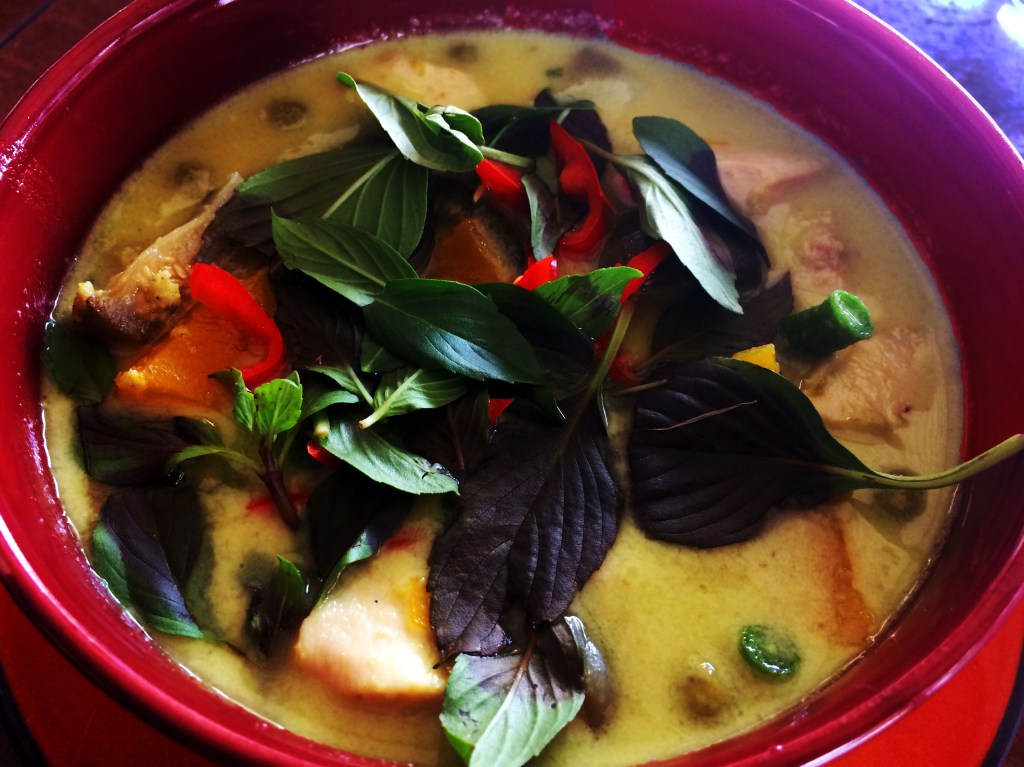
And finally, don’t let anyone shame you or convince you to eat something if you don’t feel comfortable. At the end of the day, this is your life we’re talking about. Yes, I got incredulous looks on my first night in Thailand when I ordered a tuna sandwich. You know what? I was jetlagged and nervous, and I didn’t have the energy to deal with a psychosomatic reaction – so I ordered what I knew was safe (still flashing my allergy translation card, of course).
If you don’t think a waiter really knows what you’re saying, order something else, talk to the chef yourself, go to a different restaurant. If you’re not comfortable eating something, just don’t. As I said, I came into Thailand super worried – and I’m glad I was. Because while I’ve slowly been able to let my guard down and enjoy Thai cuisine, I’ve also been 30 days without seeing the inside of a hospital. And that is something I’m incredibly grateful for.
That, and fresh coconuts.
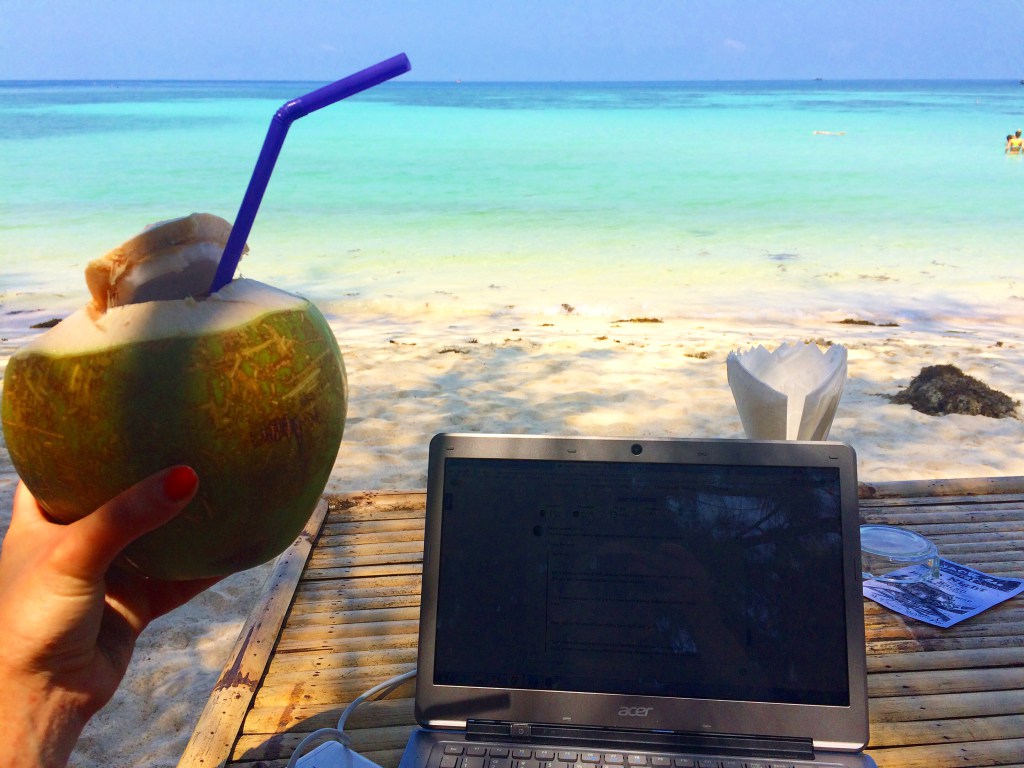
Republished with permission from Erin Morawetz. Read more about Erin’s travels on ErinMorawetz.com
Photo Credits: Erin Morawetz


COMMENTS